Strategies for diarrhoea control in poultry with natural phytobiotics
Published: October 18, 2022
By: Albert Nakielski / Specialist of poultry diseases and ornamental birds, Specialist in veterinary prevention and feed hygiene. BioPoint (www.biopoint.eu/)
About 50-70% of all antibacterial agents used in broiler production are applied to reduce bacterial intestinal infections (bacterial enteritis).
Properly conducted prophylaxis and appropriate follow-up can be effective methods of reducing the amount of antibiotics that are used in poultry production.
Impaired feed digestion and nutrient absorption lead to the development of indigestion and diarrhoea in poultry.
These diseases, apart from subclinical coccidiosis, have the greatest impact on the economics of large-scale animal husbandry.
Diarrhoeal conditions worsen production results and often necessitate the use of antibiotic therapies.
The prevailing trends indicate an increase in consumer demand for meat from certified farms, where special emphasis is placed on animal welfare and the absence of synthetic antibacterial agents.
With increasing bacterial resistance and more frequent notation of multidrug resistance strains (MRS), along with the lack of work on the development of new antimicrobial agents, tests of active substances derived from plants are currently the most promising branch of preparations that can be effective and used on a large scale, while maintaining relatively reasonable economic relations.
Fig. 1. The most important causes of digestive disturbance.
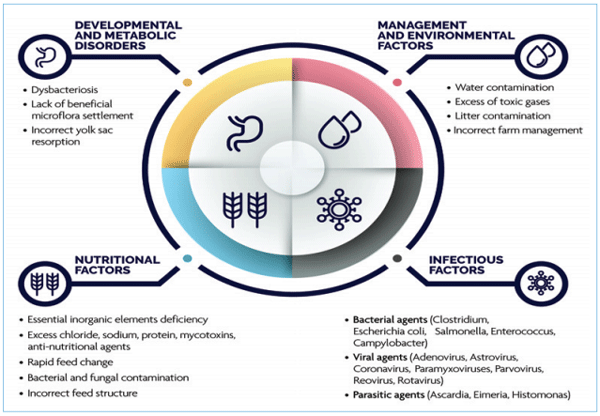
This article, which is based on more than 20 years of work on plant-based products, looks at the knowledge and solutions that are now successfully in use on poultry farms in Poland and also in several countries that are cooperating with BioPoint.
Definitions
In medical terminology as well as in the field of bird production, the three most common phrases defining the digestive tract dysfunction in poultry are: digestive indigestion, wet litter syndrome and diarrhoea.
Left to right, examples of undigested feed, wet litter and diarrhoea.

What exactly are these disorders, and how can you tell them apart when you walk around the herd?
- Digestive indigestion: Disturbance of digestion and absorption of nutrients, which is manifested by the presence of undigested feed contents in the litter.
The consequence of such disturbances is usually a reduction in the daily weight gain of birds and an increase in the feed conversion ratio (FCR).
- Wet litter syndrome: Disturbance of the ratio between liquid and solid fraction in faeces. Most often manifests itself in the hydration of the droppings with a simultaneous loss of its correct consistency and structure.
- Diarrhoea: The most severe form of impairment of digestion and the absorption of nutrients from the feed.
It is most often the result of the pathological multiplication of pathogens in the gastrointestinal tract or the unfavourable effect of their metabolites and toxins on the intestinal epithelium.
It is characterised by frequent watery faeces, which may additionally contain mucus, exfoliated epithelium or gas bubbles.
Fig. 2. Daily flock weight gain in CLINICAL CASE 1.

Table 1. Symptoms for all three clinical cases.
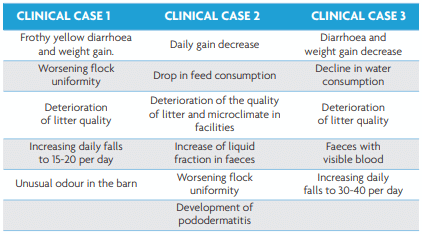
Causes
The causes of the above mentioned disorders can be found in various factors that usually occur simultaneously and in different intensity. Very often changes in the feed composition, technological stress, water pollution or subclinical infections in the flock may cause disturbance of the gastrointestinal homeostasis, accelerate the passage of intestinal contents and be responsible for mild inflammation of the intestinal epithelium.
The consequence of this may be a temporary impairment of digestion and feed absorption, which macroscopically manifests itself as indigestion, wet litter syndrome or diarrhoea on the farm.
The most important causes of these dysfunctions are listed in Fig. 1.
Regular small intestine faeces should be dense, dark brown in colour with the addition of white uric acid coating at the top. Most often they are odourless. Such faeces are excreted by the bird about 11- 15 times a day.
Caecum content is excreted once in about 7-8 small intestine excretions. Its structure is thinned, light brown, gray in colour, with increased volume.
Problems with the typical ‘wet litter’ arise when the farm has an increased amount of diluted faeces when the liquid fraction exceeds +/- 40% of its volume. Any deviation from the described structure, colour or odour should be classified as indigestion problems or as diarrhoea.
Herbal prophylaxis
Active substances contained in natural preparations belong to the group of plant secondary metabolites (PSM) and may exhibit many different biological properties in the animal organism.
Depending on their concentration and combination, they may have antibacterial and antiviral properties, as well as inhibiting the multiplication of parasites and fungi.
Moreover, they have been shown to be highly effective in stimulating humoral and cellular defence mechanisms. In addition, they can also stimulate the appetite, increase the synthesis of digestive enzymes, soothe tissue inflammation, and act as an expectorant or astringent on the digestive tract.
Achieving the above mentioned biological properties in intensive poultry production depends on the preparation used, in particular on the mixture and the concentration of phytobiotics that are in its composition. An indispensable aspect in obtaining satisfactory results in vivo is the appropriate dosage and the moment of application of such complementary feed mixtures. In view of the problem of indigestion, wet litter syndrome or diarrhoea in birds, the best effectiveness in our studies was obtained with the use of phytobiotics from the bark of Pedunculate Oak, Agrimony, Dandelion, Cinnamon and Garlic.
Recommendations
The use of specialised preparations at the appropriate moments of fattening birds may protect the flock against the development of digestive tract disorders. Thanks to the selection of the correct dose of the preparation, the combination of various products and the right moment of the application of supportive therapy, we can avoid the development of disease processes in the flock and thus reduce the need for antibiotic therapy.
Field cases
In this article, we present a description of three selected field cases in which natural antidiarrhoeal preparations were used.
CLINICAL CASE 1: Nutritional indigestion
Flock description: chicken broiler Ross308, Age: 31 days old, five objects, 30,000 birds each.
A few days before thinning, there was a sudden disturbance of the structure in faeces with the loss of its shape and the appearance of undigested feed contents.
Prior addition of a whole wheat grain to the commercial feed could have been the trigger to the disturbances in the homeostasis of the gastrointestinal tract.
Post-mortem examination:
Post-mortem examination revealed the presence of a significant amount of sticky grains in the gizzard, which could indicate poor quality of the feed or wheat grain contamination. Further sections of the gastrointestinal tract were moderately filled with lightly-digested feed and, additionally, changes were found indicating mechanical irritation of the intestinal mucosa.
Prophylactic therapy:
The participation of infectious agents was excluded in the diagnostic procedure.
Biolax V Plus 750ml / 1000l of water / 16 hours / 5 days
It was recommended to stop feeding wheat and implement the above-mentioned supportive therapy. Thanks to the quick reaction, there was no need for antibiotic therapy and the herd returned to regular production parameters. (Fig. 2)
CLINICAL CASE 1: Nutritional indigestion. From left, undigested feed contents, pododermatitis, gizzard contents and irritation of serosal mucosa.

Fig. 3. Daily water intake in CLINICAL CASE 2.
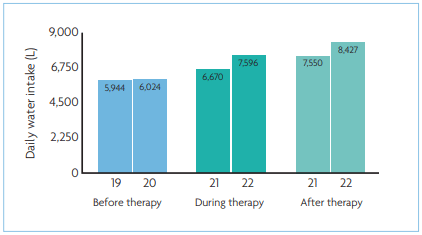
Fig. 4. Daily mortality and daily culls in CLINICAL CASE 2.
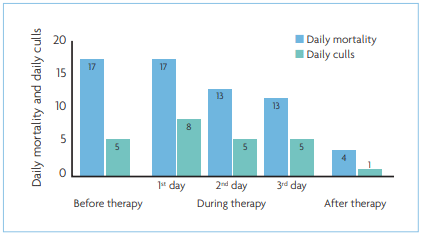
In addition, the amount of hydrated feces decreased, digestibility and feed absorption improved, as did the quality of the foodpads and the microclimate in the livestock facilities. After the supplementation was completed, regenerative therapy was implemented, including Enterocid Duo and Viovit Orego Plus.
CLINICAL CASE 2: Infectious diarrhoea, mixed aetiology
Flock description: Chicken broiler Ross 308, Age: 23 days old, one object, 38,000 birds.
During the veterinary flock inspection, symptoms indicated the development of a bacterial intestinal infection. The digestibility of feed and the condition of the birds deteriorated. Exfoliated epithelium visible on the litter indicated a disturbance of the microflora in the digestive tract.
Post-mortem examination
During the post-mortem procedure it was found that the gastrointestinal mucosa was congested, there was an excessive amount of mucus and undigested particles of the feed along the entire length of the intestines.
Characteristic changes in the gastrointestinal tract indicated simultaneous course of parasitic (Eimeria spp.) and bacterial (Escherichia coli, Staphylococcus) infection, which was finally confirmed in laboratory tests.
Prophylactic therapy:
Due to the suspected involvement of infectious agents in the course of the disease, therapeutic approach was based on the strongest combination of natural preparations. Biolax V Plus and Biotix S were used in the following combination:
Biolax V Plus 1l + Biotix S 500ml / 1000l of water / 12 hours / 5 days
Thanks to the quick reaction of the breeder and the veterinarian managing the flock, health status of the flock improved, the daily intake of water (Fig. 3) and feed increased. Daily falls and the number of culling birds decreased (Fig. 4).
CLINICAL CASE 3: Infectious diarrhoea with Clostridium spp. background
Flock description: Fattening turkey, Male Line BIG 6, Age: four weeks old, two objects, 12,000 birds each. The breeder reported squeaky behaviour of the birds and a deteriorating uniformity of the flock. During the veterinary inspection, smaller animals were noticeable, protruding from the herd, crouching in different parts of the barn.
Post-mortem examination:
The sectioned animals were significantly smaller, the pectoral muscle was dehydrated, the gizzard was filled with litter mixed with feathers, and there was a strong congestion of the duodenal epithelium.
In the jejunum and Ileum, a significant amount of mucus mixed with exfoliated epithelium, the content contains gas bubbles. Most of the intestines congested and very distended. Caecum balloon dilated and containing semi-fluid, foamy and foul-smelling content.
Prophylactic therapy:
The clinical picture of the herd and recorded tissue changes indicated the course of infection with Clostridium spp. Due to the dynamic development of the disease, immediate implementation of supportive therapy was recommended. Fallen animals and swabs from various sections of the small intestines were submitted for microbiological tests. After a few days, among others, numerous Clostridium perfringens bacteria were isolated.
Clostric 500ml + MultiActiv (mixture of organic acids) 1l / 1000l of water / 12 hours / 4 days
Enterocid Duo 250g / 1000l / 12 hours / 5 days
On the third day from the beginning of the treatment, the flock behaviour improved significantly, no dejected birds lying on the litter or showing loud behaviour were recorded. The structure of the faeces returned to the physiological picture and the daily falls stabilised at the normative level.
In the case of such a strong course of intestinal diseases, remember to use preparations containing probiotic bacteria.
CLINICAL CASE 2: Worsening bird performance and bloody diarrhoea.
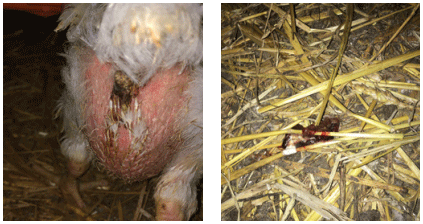
CLINICAL CASE 3: Foamy diarrhoea and distended caeca.

Summary
Due to the increasing number of disease syndromes in which several infectious agents are involved, including often highly resistant pathogenic bacteria, it becomes justified to search for alternative methods of health control in large-scale poultry production.
Professional literature often presents experiences with the use of phytobiotic preparations in a narrow scope, limited only to in vitro studies.
For field veterinarians, the most important information is the effectiveness of such complementary feed under farming conditions. Information presented in this article concerns in particular the aspect of effectiveness of mixtures of biologically active ingredients of plant extracts in everyday medical practice.
Achieved promising and repeatable effects of such therapies may certainly become a very valuable tool in the prevention of poultry.
This article was originally published in International Poultry Production • Volume 29 Number 1.
Related topics:
Authors:
BioPoint
Influencers who recommended :
David JiangRecommend
Comment
Share

Would you like to discuss another topic? Create a new post to engage with experts in the community.
Featured users in Poultry Industry

Shivaram Rao
Pilgrim´s
PhD Director Principal de Nutrición y Servicios Técnicos de Pilgrim’s Pride Corporation
United States
United States






